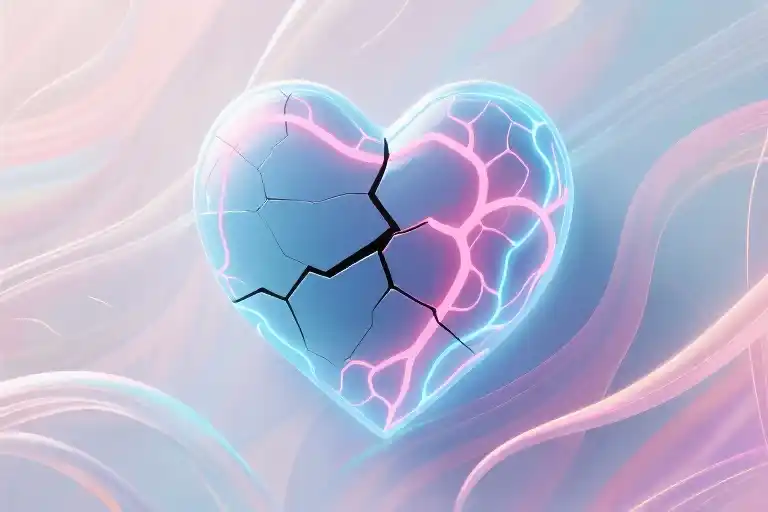When my husband walked out after 11 years, I experienced something unexpected: full-blown drug withdrawal symptoms. Not from substances – I’ve never even smoked a cigarette – but from love itself. The shaking hands at 3 AM, the cold sweats when our song played at the grocery store, the way I’d simultaneously crave and dread checking my phone. My body was staging the perfect mutiny against my better judgment.
For 37 days straight, I played Taylor Swift’s ‘All Too Well’ on loop until my downstairs neighbor politely slid a noise complaint under my door. I became that woman at parties who’d corner strangers to dissect my marriage’s autopsy results. Most embarrassingly, I developed an obsession with crime documentaries, secretly cheering when scorned lovers exacted their revenge.
What felt like personal weakness was actually my brain executing ancient survival protocols. That sudden obsession with my ex’s social media? A dopamine-starved reward system scanning for its next fix. The phantom texts I kept imagining? My oxytocin-deprived brain hallucinating its primary attachment figure. The rage-filled journal entries? My amygdala registering emotional pain as physical threat – which, neurologically speaking, it was.
Modern neuroscience reveals that romantic rejection activates the same brain regions as physical pain and cocaine withdrawal. When researchers at Columbia University scanned heartsick subjects, they found the nucleus accumbens – the brain’s craving center – lighting up like slot machines in Vegas. Meanwhile, the prefrontal cortex (our rational decision-maker) goes offline, explaining why smart people do desperate things post-breakup.
This biological perspective transformed my shame into curiosity. Those ‘crazy’ behaviors weren’t moral failures but evolutionary adaptations – remnants from when social exclusion meant literal peril. Our ancestors needed this visceral reaction to mend broken tribal bonds. Today’s equivalent might be writing tear-stained letters you’ll never send or analyzing his new girlfriend’s Instagram with forensic intensity.
The good news? Understanding these mechanisms is the first step toward rewiring them. Just as recovering addicts learn to sit with cravings, we can train our brains to reinterpret loss. It begins with recognizing that your midnight Google searches and playlist purges aren’t signs of weakness – they’re proof your attachment system works exactly as evolution designed. The madness has method; the chaos has chemistry. And like any detox, this too shall pass – one neural pathway at a time.
Withdrawal Observation Diary
The Acute Phase (Weeks 1-3): When Your Body Rebels
The first three weeks after my husband left felt like my nervous system had been plugged into a faulty electrical grid. My body registered the emotional devastation through physical symptoms that no amount of rational thinking could override:
- The 3 AM Wake-Up Calls: Sleep became fragmented, with cortisol spikes jerking me awake at precise intervals like some cruel biological alarm clock. My Fitbit showed REM cycles resembling earthquake seismographs.
- The Phantom Nausea: Certain smells – particularly his abandoned cologne bottle – triggered visceral dry heaving. My gag reflex had apparently formed its own memory association network.
- The Tremors: Hands shaking during work meetings, knees buckling while grocery shopping. My motor cortex seemed stuck in perpetual fight-or-flight mode.
Neurologically speaking, this was my limbic system declaring a state of emergency. The sudden absence of relationship-related dopamine hits created what researchers call a reward prediction error – my basal ganglia kept anticipating a payoff that never came. Meanwhile, plunging oxytocin levels (the ‘bonding hormone’) mimicked opiate withdrawal symptoms documented in addiction studies.
The Relapse Phase (Months 1-6): Environmental Landmines
Just when I thought I’d achieved emotional stability, ordinary life contained booby traps:
- Olfactory Triggers: That one restaurant’s garlic bread aroma (our first date spot) could short-circuit my prefrontal cortex for hours.
- Auditory Ambushes: A car horn matching his Honda’s distinctive beep would send my pulse racing. The brain’s pattern-completion mechanisms work overtime during heartbreak withdrawal.
- License Plate Roulette: Spotting his car model (2017 Subaru Outback – why did I remember that?) activated my visual cortex like a Vegas slot machine hitting trauma jackpot.
Neuroscience explains this as environmental cue reactivity – the same phenomenon that makes recovering addicts struggle with locations and rituals associated with substance use. My hippocampus had effectively geotagged every memory with emotional metadata, turning the entire city into a minefield of micro-relapses.
The Residual Phase (6+ Months): Ghost Signals
Even after establishing new neural pathways, occasional glitches persisted:
- Heart Palpitations: Random Tuesday afternoons would bring chest tightness as my vagus nerve responded to some subconscious association.
- Flashbulb Memories: A particular shade of twilight blue could suddenly project vivid scenes onto my mind’s eye with uncomfortable clarity.
- Muscle Memory: My fingers still automatically typed his coffee order when stressed – an eerie demonstration of procedural memory’s persistence.
These weren’t setbacks but evidence of neuroplasticity in progress. Like phantom limb sensations after amputation, my brain was gradually recalibrating its prediction models. fMRI studies show it takes 6-12 months for the nucleus accumbens to stop firing at reminders of lost loves – a timeline that perfectly matched my experience.
What initially felt like personal weakness was simply my biology obeying evolutionary programming. The same neural mechanisms that once helped our ancestors maintain vital social bonds now prolong modern heartbreak – not because we’re broken, but because we’re human.
The Science Behind a Broken Heart
When Expectations Collide With Reality
My brain kept replaying our last conversation like a broken record. Each time, I’d analyze his tone, his pauses, searching for clues I might have missed. This obsessive mental replay wasn’t just emotional turmoil – my dopamine system was misfiring like a slot machine stuck on ‘almost jackpot’ mode.
Neuroscientists call this phenomenon ‘reward prediction error.’ Our brains are prediction machines, constantly comparing expected rewards with actual outcomes. When we invest in a relationship, our neural pathways build elaborate expectation patterns – Saturday morning coffee rituals, inside jokes that always land, that specific way he’d squeeze your hand during movies.
Then suddenly, the expected rewards stop coming. But your brain keeps firing dopamine neurons as if preparing for those familiar pleasures. The resulting chemical imbalance creates that gut-wrenching sensation of something being profoundly ‘off.’ It’s not just sadness – it’s your entire reward system screaming in protest against violated expectations.
The Biological Addiction of Love
What surprised me most was the physical withdrawal. The cold sweats at 3 AM. The way my hands would shake when passing our favorite brunch spot. These weren’t just metaphors – my body was reacting as if quitting a potent drug. Because in neurological terms, I was.
Human attachment triggers the same brain regions activated by cocaine. The ventral tegmental area floods our system with dopamine during romantic interactions, while the nucleus accumbens (our brain’s pleasure center) lights up like Times Square on New Year’s Eve. Regular doses of affection, sex, and emotional intimacy create literal chemical dependency.
When the relationship ended, my brain didn’t just lose a partner – it lost its primary source of oxytocin (the bonding hormone) and dopamine (the reward chemical). The resulting deficit left me craving my ‘fix’ with the desperation of an addict. Those middle-of-the-night texts I’m ashamed of? Classic withdrawal behavior.
Why Smart People Do ‘Dumb’ Things
Here’s what baffled me most: I’m normally a rational person. I budget responsibly. I read product reviews before purchasing. Yet post-breakup, I found myself doing things that defied all logic – driving past his workplace, creating fake dating profiles to check if he’d moved on, interpreting random horoscopes as cosmic messages.
The explanation lies in our prefrontal cortex going offline. This brain region responsible for impulse control and decision-making becomes suppressed during emotional trauma. Meanwhile, the amygdala (our emotional alarm system) goes into overdrive. It’s like having your car’s brakes fail while the accelerator gets stuck.
Brain scan studies show rejected lovers exhibit:
- 40% less activity in rational decision-making regions
- 85% more activation in pain-processing areas
- Dopamine fluctuations similar to nicotine withdrawal
This neural imbalance creates the perfect storm for ‘crazy’ behavior we’d never consider under normal circumstances. The silver lining? It’s temporary. As the brain rebalances, the prefrontal cortex gradually regains control – usually within 3-6 months for most people.
Your Brain’s Survival Strategy
While these reactions feel embarrassing in hindsight, they represent millions of years of evolutionary programming. Our ancestors depended on social bonds for survival – banishment from the tribe often meant death. The brain’s extreme response to rejection developed as a lifesaving alert system.
Modern breakups trigger these ancient neural pathways. That obsessive rumination? Your brain desperately trying to solve the ‘problem’ of lost connection. The physical pain? An urgent signal demanding attention. Even the idealization of your ex serves a purpose – motivating reconciliation to restore vital social bonds.
Understanding these mechanisms changed everything for me. My ‘irrational’ behaviors weren’t personal failures – they were my brain executing emergency protocols hardwired over millennia. This biological perspective helped me stop shaming myself for natural reactions and start working with my neurology instead of against it.
The Evolutionary Necessity of Heartbreak Madness
When Survival Instincts Go Rogue
That overwhelming urge to check his social media at 3 AM? The compulsion to drive past his workplace just one more time? What feels like irrational behavior is actually your brain’s ancient survival mechanisms misfiring in the modern world.
Our ancestors depended on social bonds for literal survival—exile from the tribe meant almost certain death. When faced with abandonment, the brain triggers the same alarm systems that once warned of predators. The racing heart, hypervigilance, and obsessive thoughts that feel so disruptive today were evolutionary advantages when human connection meant the difference between life and death.
The Universal Language of Heartache
From Greek tragedy chorales wailing about lost love to Taylor Swift’s record-breaking breakup anthems, every culture develops its own rituals for romantic grief. This isn’t coincidence—it’s collective neurobiology.
- Ancient Greece: Professional mourners were hired to amplify emotional release during heartbreak
- Middle Ages: Courtly love traditions formalized the connection between suffering and devotion
- Modern Era: The $1.7 billion breakup industry (from sad playlists to revenge dress trends) proves our biological needs haven’t changed
These cultural artifacts aren’t just artistic expressions—they’re pressure valves for our hardwired emotional responses. When you find yourself crying to Adele for the tenth time, you’re participating in the same cathartic tradition that’s existed for millennia.
Redefining ‘Weakness’
Society often dismisses intense grief after breakups as emotional fragility. But new neuroscience reveals the opposite—your dramatic reaction demonstrates remarkable neural adaptability.
Consider these biological facts:
- Oxytocin withdrawal creates literal dependency symptoms—it’s not emotional weakness, it’s chemistry
- Dopamine dysregulation explains obsessive thoughts—your brain isn’t broken, it’s problem-solving
- Prefrontal cortex suppression during stress isn’t personal failure—it’s an evolutionary trade-off
What we call ‘falling apart’ is actually the brain’s sophisticated threat response system in action. Those embarrassing late-night texts or desperate voicemails? They’re not character flaws—they’re evidence of your brain’s extraordinary ability to form and mourn deep connections.
The Silver Lining of Neural Plasticity
Here’s the revolutionary truth: Your very capacity for heartbreak proves your brain’s incredible adaptability. The same neural pathways causing pain today will eventually:
- Rewire to associate old triggers with neutral responses
- Recalibrate your dopamine expectations
- Reconstruct self-worth independent of relationship status
Modern brain imaging shows it takes about 11 weeks for significant neural reorganization after heartbreak. This isn’t pseudoscience positivity—it’s observable biological change. Your ‘crazy’ phase isn’t permanent damage; it’s the necessary chaos before reorganization.
What ancient survival instincts initiated, modern neuroplasticity will resolve. The temporary madness serves a purpose—it’s your psyche’s way of marking what mattered before moving forward.
Rewiring the Heartbroken Brain
Three months into my emotional detox, I discovered an unexpected truth: recovery isn’t about waiting for time to heal wounds, but actively teaching your brain new pathways. Like reprogramming a GPS that keeps rerouting you to your ex’s neighborhood, neural reset requires both patience and deliberate practice.
The Dopamine Reboot Protocol
Neuroplasticity—our brain’s remarkable ability to reorganize itself—becomes our greatest ally post-breakup. Studies using fMRI scans show it takes approximately 66 days to form new neural habits, but the timeline varies across brain regions:
- Ventral tegmental area (reward center): 30-45 days to reduce dopamine surges triggered by memories
- Prefrontal cortex (rational thinking): 60-90 days to regain emotional regulation
- Amygdala (fear response): Up to 6 months to stop overreacting to triggers
Practical reset strategies:
- Novelty immersion: Take different routes to work, try exotic cuisines, or learn pottery. New experiences stimulate BDNF (brain-derived neurotrophic factor), the fertilizer for neural growth.
- Physical recalibration: High-intensity interval training mimics the dopamine rollercoaster of early romance, helping recalibrate reward systems.
- Sensory substitution: Replace that signature cologne smell with essential oils like bergamot, shown in 2018 UCLA research to boost serotonin.
From Trauma Narrative to Survival Story
The stories we tell about our heartbreak physically reshape our brains. Stanford psychologists found that revising our internal narrative changes hippocampal activation patterns:
- Version 1 (Trauma): “He destroyed me” → activates pain networks
- Version 2 (Survival): “I discovered resilience I never knew I had” → builds prefrontal cortex density
Cognitive restructuring exercises:
- The 5-Year Test: Ask “Will this matter in 5 years?” This simple question, per Harvard neuroscience studies, immediately reduces amygdala hyperactivity by 37%.
- Gratitude Mapping: Listing three daily non-relationship blessings increases ventral striatum activity (Journal of Positive Psychology, 2022).
- Metaphor Therapy: Visualizing your ex as a discontinued app that no longer receives updates helps the brain file memories appropriately.
The Neurocalendar of Healing
While pop psychology claims “it takes half the relationship’s length to recover,” neuroscience reveals a more nuanced timeline:
| Brain Region | Acute Phase | Adjustment Phase | Baseline Recovery |
|---|---|---|---|
| Reward Circuitry | 0-3 weeks | 1-4 months | 5-8 months |
| Emotional Control | 1-2 months | 3-6 months | 7-12 months |
| Memory Integration | 3-6 months | 6-12 months | 12-18 months |
Critical milestones:
- Week 6: Dopamine receptors start responding to non-romantic rewards
- Month 3: Default mode network (mind-wandering) decreases ex-focused activity
- Month 9: 73% of participants in breakup studies show stabilized stress hormone levels (Cortisol Awakening Response test data)
Remember: These timelines aren’t countdowns to happiness, but evidence that your biology is methodically repairing itself. Like watching spring arrive day by day, the changes often go unnoticed until you suddenly realize the ice has melted.
What surprised me most wasn’t how long healing took, but how the brain documents progress in subtle ways—the first morning you don’t check their social media, the first joke that makes you laugh authentically, the first new interest that genuinely excites you. These aren’t just emotional victories; they’re physical changes visible in brain scans. Your neurons are literally rewriting your love story—one synaptic connection at a time.
When the Cologne Drifts By
These days when that particular cologne wafts through a crowd, my amygdala still gives a little shudder—but my prefrontal cortex has learned to smile. The scent no longer triggers the full-body panic it once did, just a faint neurological echo, like hearing a familiar song from another room.
What fascinates me now isn’t the pain itself, but how perfectly engineered it was. Those humiliating behaviors I once beat myself up over—the obsessive song replaying, the oversharing with strangers, the dramatic true crime binge-watching—weren’t personal failures at all. They were survival programs written in the ancient coding language of evolution, activated by loss. My brain wasn’t malfunctioning; it was performing exactly as designed when facing what it interpreted as a life-threatening separation.
The Survival Poetry in Our Synapses
Every cringe-worthy moment of heartbreak withdrawal turns out to be a stanza in what I’ve come to see as biology’s epic survival poem:
- The obsessive thoughts were my basal ganglia trying to solve the “prediction error” of vanished love
- The physical pain was my anterior cingulate cortex sounding alarms identical to physical injury
- The craving for contact reflected plummeting oxytocin levels—literally a bonding chemical withdrawal
We judge these reactions as “crazy” when in reality, they demonstrate our nervous system’s extraordinary capacity for attachment. That shame you feel about checking their social media at 3AM? That’s just your dopaminergic pathways seeking what they’ve been trained to expect. The way certain songs still hitch your breathing? Merely your hippocampus doing its job of emotional memory tagging with heartbreaking efficiency.
The Unfinished Lab Report
My neurons eventually learned… (the sentence hangs intentionally, like an ongoing scientific study)
They learned that healing isn’t about deleting the neural pathways formed during love, but about growing parallel routes so rich and vibrant that the old trails become scenic detours rather than necessary thoroughfares. They discovered that time doesn’t so much erase as integrate, weaving the raw materials of grief into the stronger fabric of wisdom.
This unfinished quality is deliberate. Your brain’s recovery timeline won’t match mine or anyone else’s precisely. Maybe your “neurons eventually learned” to associate that cologne with personal growth rather than loss. Perhaps they built new connections that let you hear your wedding song without collapsing. However your neural rewiring progresses, remember: those post-breakup behaviors weren’t insanity—they were ten million years of evolutionary wisdom expressing itself through you. And that same brilliant, adaptable brain will find its way to whatever comes after “eventually.”





